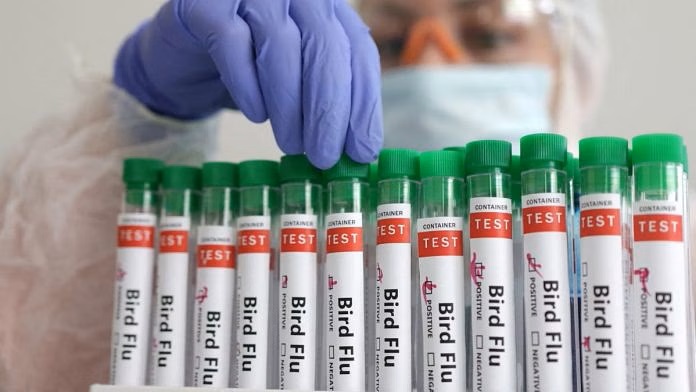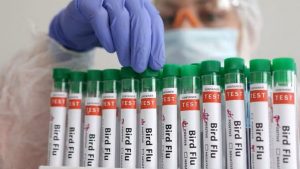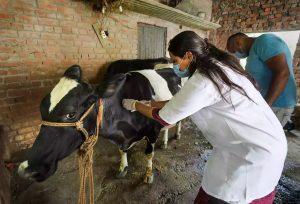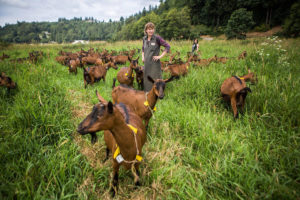Failure to shield these workers could allow the H5N1 virus to become a greater threat.
Jennifer B. Nuzzo is a professor of epidemiology and the director of the Pandemic Center at Brown University School of Public Health. Lauren Sauer is an associate professor at the University of Nebraska Medical Center and the director of the Special Pathogen Research Network. Nahid Bhadelia is an infectious diseases physician and associate professor and the founding director of the Center on Emerging Infectious Diseases at Boston University.
The discovery of bird flu virus particles in milk has moved the federal government to take more aggressive action to prevent the further spread of H5N1 on dairy farms. The Agriculture Department has rightly issued new testing recommendations meant to keep the virus from spreading across state lines. But this additional testing will do little to address the primary threat that H5N1 poses to humans: the infection of farmworkers. Our failure to protect them threatens their health and gives the virus an opportunity to evolve into a greater threat to people, including those who live far from dairy farms.
The discovery of viral material in milk sold in American stores is not in itself alarming. Pasteurization, though it doesn’t remove pathogens, destroys their ability to infect people. Follow-up testing has confirmed this: Researchers have not been able to isolate and grow the virus from pasteurized milk.
But H5N1 poses risks to dairy workers, who may be exposed to infected cows and to milk before it is pasteurized. So far, only one dairy worker in the United States is known to have been infected, and fortunately this person experienced only mild eye inflammation. But there are reports that other dairy workers have gotten sick at the same time that cows have. Veterinarian Barb Peterson told Bovine Veterinarian, “There’s been underreporting of the virus. Understandably, there’s been a lot of fear. But every dairy that I’ve worked with has — with the exception of one — had sick human beings at the same time they had sick cows.”
These reports are concerning, not because the infections are severe but because any rise in human infections boosts the chances that the virus will find its way to someone who has more medical conditions and may have a worse disease outcome if infected. And H5N1 has not historically been mild in humans. Of the almost 900 known cases of H5N1 infection in humans worldwide, the virus has killed about half.
So it is crucial to protect from exposure farmworkers who are likely to be in contact with infected animals. The eye protection and masks recommended by the Centers for Disease Control and Prevention should be readily available to all dairy workers. All states have access to this protective equipment, but making sure dairy farms and operations provide it to their workers and normalize its use will take education.
Dairy workers also need H5N1 vaccines; efforts to make them available need to be expedited. And because many farmworkers are immigrants, work is needed to overcome both a widespread lack of health insurance and strong financial and legal disincentives to report infections.
U.S. health officials have said that the virus now showing up on dairy farms is a good match for vaccines under development. But they have not been clear about the status of vaccines in the existing stockpile, or when the Food and Drug Administration might authorize them to be used. As we learned from covid-19, delays in vaccination could lead to unnecessary deaths.
Protecting workers and preventing the next pandemic also require greater virus surveillance on farms and in dairy processing facilities. The USDA’s updated requirements, which mandate the testing of lactating cows only when they are about to move to another state, won’t protect farmworkers. The tests have to be sent to laboratories, and this delays results that would signal the need to protect people. More widespread testing on dairy farms remains voluntary and limited to animals with symptoms — despite evidence that cows experience asymptomatic infections and that other farm animals also have been infected.
Wider testing of cows is challenging but essential, as is expanded testing of workers in the dairy industry. Everyone working on dairy farms needs immediate access to antiviral medications in case an outbreak occurs. Rapid tests need to be quickly developed so that samples can be analyzed on farms rather than sent away to labs. And it is crucial to regularly sequence virus samples isolated from cows in order to monitor any genetic mutations that could improve the virus’s ability to infect humans or to evade antiviral medicines. The USDA has so far been slow to share genetic information on virus samples gathered from infected cows, and this must change immediately.
Preventing farmworker infections and uncontrolled spread in mammals is key to stopping the virus from spreading more easily among humans. This requires active coordination among federal, state, and local agricultural and public health officials.
You can now read the most important #news on #eDairyNews #Whatsapp channels!!!
🇮🇳 eDairy News ÍNDIA: https://whatsapp.com/channel/0029VaPidCcGpLHImBQk6x1F











